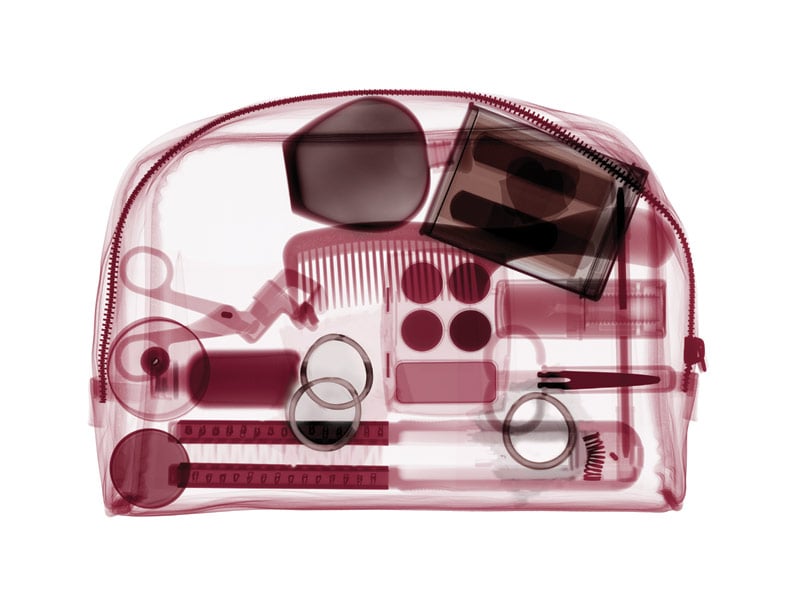To help us face the world with confidence we call upon products that cosmetic chemists have devised to make us look good and feel good about ourselves, but what do we really know about these ‘secret’ formulas?
Dr John Emsley reveals all about the ‘real’ ingredients inside the products in your beauty bag…
LIPSTICK AND LIPGLOSS
These are a blend of oil, wax and dye plus various beneficial additives. In lipstick, the percentage of wax is higher so it keeps its shape. A typical oil is macadamia seed oil, which has a silky feel and is mainly oleic acid. Octyldodecyl stearate is also used and this slows down water loss from the lips making them appear plumper. The wax is either beeswax or purified wax from oil. Also included are titanium dioxide which has excellent covering power, silicone oil to protect the layer of gloss while on the lips, butylated hydroxytoluene (BHT), as an anti-oxidant.
MASCARA
The black of mascara is carbon black, which is produced from oil and is the black pigment of car tyres and printing inks. This is blended with a mixture of wax and oil. One popular wax is carnauba wax, which is extracted from the leaves of a Brazilian palm tree. The oil is usually mineral oil. The ingredients are blended with a thickening agent such as tragacanth gum to form a soft paste. Sometimes guanine is added to give the mascara a little shine, but this doesn’t come from bat droppings as rumoured.
Related Story: Get Abs In Less Than 10 Mins thanks To Beauty Genius Huda Kattan
FAKE TAN
When skin comes in contact with dihydroxyacetone, aka DHA, its proteins react, forming melanoidins, which are brown in colour, thereby giving the appearance of a tan. Tanning lotions contain between 2 per cent and 5 per cent DHA, while those used by professionals have up to 10 per cent. These products have to be slightly acidic, and this is done by added a little phosphate to give a pH of 5. An alternative to DHA treatment is erythrulose, but its tan is lighter and doesn’t last as long.
WHITENING MOISTURISER
There are several skin-whitening chemicals, namely kojic acid, licorice extract, scutellaria extract and mulberry. They work by blocking the enzyme tyrosinase, which produces the melanin pigment of dark skin. The best is kojic acid which is a natural chemical but can also be manufactured. A more powerful skin-whitener is hydroquinone but this is now banned in many countries because it can cause dermatitis (skin inflammation and irritation). Other ingredients in skin-whitener are glycolic acid, which removes the surface layer of skin, an acid stabiliser to keep the pH at 4 and sodium metabisulfite to act as a preservative.
HAIR DYE
The dye molecules which produce permanent colours have to be created within the hair itself and this is done in three stages. First, the tiny cuticles of the hair have to be opened and this is done by raising the pH with an ammonia compound. Then a mixture of hydrogen peroxide, which removes the existing colour, and paraphenylenediamine (PPD), are applied and penetrate the hair. Next the dye-precursor is added and when this comes in contact with the PPD it forms the desired colour. A final rinse closes the hair cuticles and the new dye is trapped and won’t wash out.
Related Story: Top 5 Instant Beauty Fixes
FIRM HOLD HAIRSPRAY
Polymers PVP and PVA are the chemicals that hold the hair in place. A slightly better polymer is one made from vinyl acetate and methyl acrylic acid, which has the added advantage of washing out of the hair more easily and, because it’s soluble in water, it can be supplied in this solvent rather than in alcohol like the PVP and PVA. The gas which propels the hairspray from the can is either butane or one of the newer types known as hydrofluorocarbons (HFCs), which have replaced the ozone-layer damaging CFCs.

The ‘real’ contents of your beauty cabinet will shock you
EYE DROPS
The active ingredients in these are boric acid and its salt sodium borate, aka borax. These are mild antiseptics. Also included is witch hazel extract, which is a natural anti-inflammatory agent with healing properties. Eye drops also contain glycerol, which is a viscous liquid and so makes the drops less watery and more soothing. Benzalkonium chloride is also added as an antibacterial agent.
SENSITIVE TOOTH TOOTHPASTE
The key ingredients are arginine and calcium carbonate (limestone). Together these can repair tooth enamel. Arginine neutralises the bacteria which causes decay, while the calcium repairs and fills any holes in the enamel. Fluoride in the form of sodium monofluorophosphate strengthens the tooth enamel. This is the mineral hydroxyapatite and fluoride makes it tougher and acid-resistant. Toothpaste also contains the surfactant sodium lauryl sulfate to clean the teeth, sorbitol to keep it moist, and xanthan gum to hold all the ingredients together. Titanium dioxide is the white pigment.
Related Story: How To Perfect The Off-Duty Daytime Look
MOUTHWASH
This kills the microbes that cause bad breath by feeding on sulphur-containing proteins. The natural anti-bacterial agents are eucalyptol from the eucalyptus oil, thymol, a natural oil with strong antiseptic properties, and menthol which occurs naturally in peppermint oil. Menthol activates the cold-sensitive receptors in the mouth, producing a fresh feel. To keep all these ingredients soluble, oloxamer polymer is added. Benzoic acid and sodium benzoate are there as antibacterial agents. Many conventional mouthwashes also contain alcohol.
NAIL VARNISH REMOVER
The most commonly used solvent is acetone, and while this does the job extremely well, it also removes natural oils from the nail, making them brittle and the surrounding skin dry and prone to cracking. To counteract this, other ingredients such as glycerol and aloe vera are added. There are gentler solvents which can be used, such as ethyl acetate, isopropanol, propylene carbonate or toluene. These are not so aggressive in removing essential oils. Even so, natural oil such as bitter orange oil may be included in the formulation.
Related Story: DIY Beauty Tricks That Are All Natural
HAIR REMOVAL PRODUCTS
Hair relies on sulphur-to-sulphur bonds for its structure and strength. Break these bonds and it’s weakened, becoming detached from its follicles and so it can be wiped away. The chemicals that react with the sulphur atoms and break their bonds are those with a high pH which is why the ingredients in hair removers are either calcium hydroxide (slaked lime), or sodium hydroxide (caustic soda), or a combination of the two. Other hair-removal creams are based on potassium and calcium thioglycolate, which carry out the same chemical reaction.












